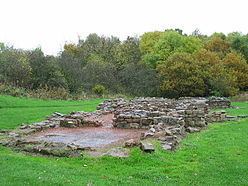County North Lanarkshire UK-OSNG reference NS731575 | Country Scotland | |
 | ||
Bothwellhaugh Roman Fort is the remains of a Roman legionary fort in North Lanarkshire near Glasgow. It is commonly, but falsely, said to have been known as Clotagenium ("Clyde-mouth") to the Romans, but that name does not in fact exist in the Ravenna Cosmography, its alleged source.
It was built as part of the western side of the Antonine Wall around 142 CE. A comparable eastern site would be Inveresk Roman Fort. The fort's defenses consisted of a turf and clay rampart 23 1⁄2 feet (7.2 m) thick, supported on thick sandstone foundation slabs, part of which was preserved to a height of around 5 ft (1.5 m). A 33 ft (10 m) wide berm separated the fort wall and the first of two ditches, each measuring about 15 ft (4.6 m) wide and 4 ft (1.2 m) deep, and spaced 7 ft (2.1 m) apart. It was built in a rhomboid pattern and was large enough to house both troops and cavalry. A number of artifacts were taken from the excavations on the site, such as a carved drain cover, to the Hunterian Museum at Glasgow University and are now on show there.
Near the fort are the well preserved remains of a Roman Bath house and a medieval copy of an original Roman Bridge over the South Calder Water. The distance from the thermae (baths) to the fort suggests there are other, as yet undiscovered structures.
